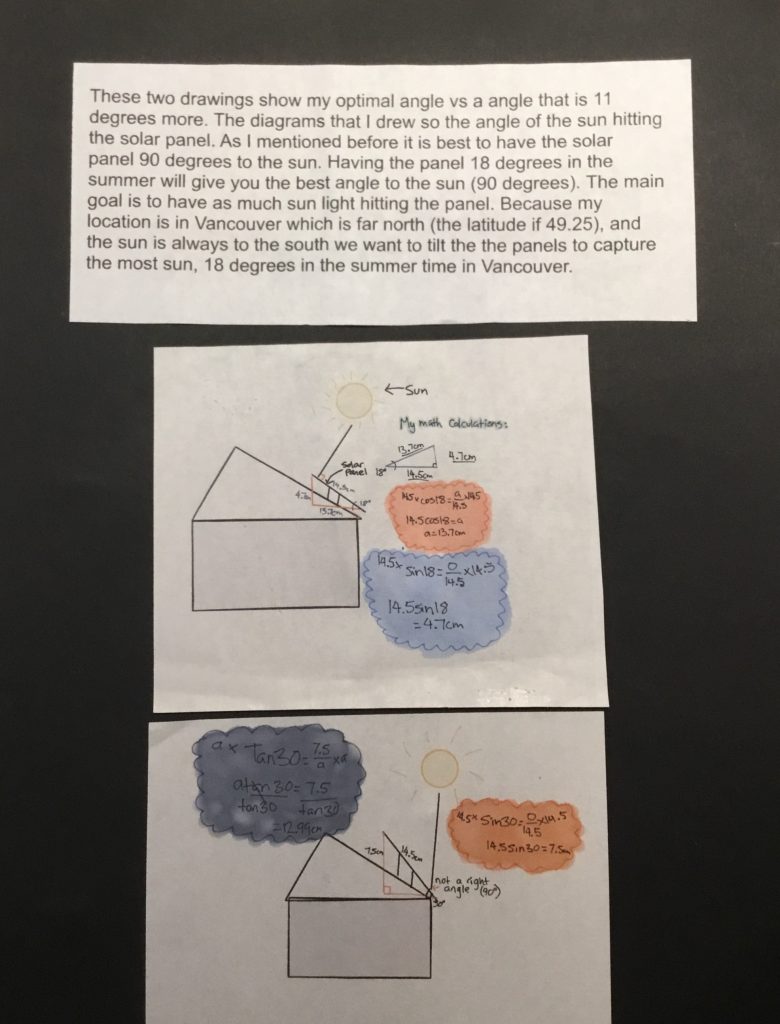This math unit was based on trigonometry. After learning how to solve trigonometry questions and how to find the angles of a triangle using trigonometry, the whole class was assigned a project. The project was, to build a solar panel and using trigonometry, we had to find the optimal angle that the angle would have to be placed at to get the most energy from the sun. We also had to do a write up of the information explaining our model. The question we had to answer/ show was, How can we use trigonometry to optimize clean energy technologies?
To help us have a better understanding on how you find the angle and side lengths, we did a lab. Using a wooden divider with a mini solar panel attached to it as a roof, and wooden blocks to slowly make the angle larger and larger until we found the angle that produced the most energy. To measure the energy, we were given voltmeters . We were using the lights in the class as the sun. Me and my partner concluded that using 8 blocks and having the angle at 35.7 degrees got the most energy from the lights. The hight of the triangle was 32cm and the length was 23cm. The voltmeter read .97 volts. Using under 8 wasn’t very affective, for example using 3 blocks. The angle was 21.25 degrees. The height was 14cm and the length was 36 cm. The voltmeter only read .89 volts.
We also did a few worksheets to figure out how to find the angles of triangles using trigonometry. There was a specific question that was a challenge to figure out, and in the end did it as a class. Here are the steps:
Before we started building our models, we needed to figure out what the best optimal angle was. We could choose the optimal angle for one season. I researched the optimal angle for all of the seasons.
☀️Winter – 64 degrees
🌸Spring/fall – 41 degrees
❄️Summer – 18 degrees
I chose to use the summer angle. The best optimal angle for summer is 18 degrees. For the solar panel to get the most energy the panel had to be 90 degrees with the sun.
Once we had our angle, using trigonometry we now had to figure out what the side lengths were for the triangle. Here are my equations:
Now it was time to start building. I knew that would take me the longest time. I decided to make a house. For the house I used a shoe box for the base and to make it look like a house I cut out windows and built a roof out of cardboard. To make the roof look more interesting I glued lollipop sticks to it, the lollipop sticks also gave it more of a roof affect. I just painted the shoe box brown to make it look like a wood house. In grade 8 for a project I used fake grass and I had some left over so I put the house on top of the grass. To show that the sun had to be 90 degrees with the panel, I made made a small model of the sun out of tissue paper.
On our models we needed to show the angle, and the right angle triangle. We also had to label all of the side lengths. I used lollipop sticks to make the right angle triangle. When our teacher came around to mark them, he measured the angles and side lengths of the triangle, to make sure your measurements were correct.
As Sydney and I were working on our projects, there was a power cut. We had no wifi, my iPad was low on battery and I needed to glue gun my model together. The glue wasn’t working because I needed power, so in the end I had to leave it for a bit. The power cut was longer than we thought, and we both had to finish our projects because they were due the next day. By the end we ended up going to Parkgate library, to finish the write ups. Luckily when I got home the power came on and I was able to finish my project.
On my write up, it explained the optimal angle and why that is. I also explained how my model would be different if I was to build a real life building. I would, change all of the centimetres to metres. For the materials I would use wood for the structure and sleet for the roof lastly the solar panel would be real one.
When we were done I got a pretty good mark, I just needed to add more detail about the connection between the solar panel angle constraint and the sun.
 I enjoyed this project because we got to be very creative and personalize our models. I learned how solar panels work and how there is a specific angle for each season.
I enjoyed this project because we got to be very creative and personalize our models. I learned how solar panels work and how there is a specific angle for each season.
Here is my project reflection:









